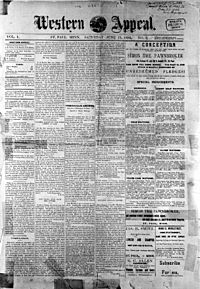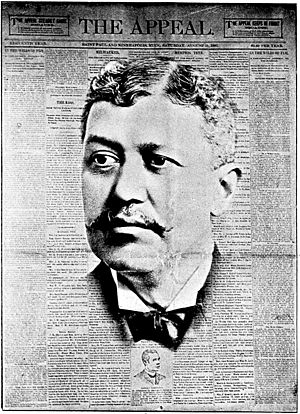The Appeal (newspaper) facts for kids

June 13, 1885 front page of Western Appeal
|
|
| Type | Weekly newspaper |
|---|---|
| Format | Broadsheet |
| Founder(s) | Samuel E. Hardy John T. Burgett Frederick Douglass Parker |
| Publisher | Parker Burgett & Hardy Publishing Company |
| Founded | June 5, 1885 |
| Political alignment | Republican |
| Language | English |
| Ceased publication | 1923 |
| Headquarters | St. Paul, Minnesota |
| ISSN | 2163-7083 |
| OCLC number | 10153837 |
The Appeal (first called the Western Appeal) was a newspaper that came out every week. It was published from 1885 to 1923. This newspaper was very successful for African American newspapers in the late 1800s and early 1900s. It started in St. Paul, Minnesota. When it was most popular, it was printed in six different cities across the United States. In 1889, its name changed to The Appeal. This showed that it was now reaching many more places.
Contents
The Story of The Appeal Newspaper
How The Appeal Newspaper Started
In 1885, fewer than 1,500 African Americans lived in the Minneapolis–Saint Paul area. Many African American newspapers existed back then. But most of them did not last long, often less than a year. This was because they were started more for cultural reasons than to make money.
There had been other African American newspapers in St. Paul before. One was even called the Western Appeal in 1876. But that paper was not connected to the one started in 1885.
The Western Appeal newspaper first came out on June 5, 1885. It was published in St. Paul, Minnesota. Samuel E. Hardy and John T. Burgett started it with Frederick Douglass Parker. Parker was also the newspaper's first editor. It was a weekly paper, meaning a new edition came out every Friday. It had news, opinion pieces, ads, and a page for stories and poems.
Subscribing to the paper was cheap, only two dollars a year. But the newspaper was already having money problems by the end of 1886.
Early Challenges and New Leadership
In December 1886, Frederick Douglass Parker stopped being the editor. A new team took over the newspaper. Important businessmen from St. Paul, Thomas H. Lyles and James Kidd Hilyard, led this team. They used their own money to save the paper.
In February 1887, the team reorganized as the Northwestern Printing Company. This company did other printing jobs besides publishing the Western Appeal. This extra work helped the newspaper stay in business for a long time.
Lyles and Hilyard first asked Parker to come back as editor. But by January 1887, Parker had left again for another job. So, Lyles and Hilyard promoted John Quincy Adams to editor. Adams had been an editor for a similar newspaper called the Bulletin in Louisville, Kentucky. He moved to St. Paul in 1886 to work at the Western Appeal. Once he became editor, Adams became the main person driving the newspaper forward.
Adams was a very good writer. He was also a strong supporter of the Republican Party. Like other editors of his time, he shared his views in the newspaper's opinion section. The Western Appeal even received money directly from the Republican Party. This was a common practice for newspapers back then.
Growing Bigger and Changing Its Name
In January 1888, Adams opened a new office for the paper in Chicago. His brother, Cyrus Field Adams, managed this office. This helped the Western Appeal reach even more readers. More offices opened later: Louisville in August 1888, St. Louis in April 1889, Dallas in August 1892, and Washington, D.C. in March 1901.
Each Saturday, these offices published their own version of the newspaper. All editions had the same national news, main articles, and opinion pieces. But each one also had its own local news and social updates. The word "Western" was removed from the paper's name in 1889. This showed that it was now a national newspaper. By this time, Adams owned The Appeal completely. He managed both the business and the writing parts of the paper.
Like other newspapers of its time, The Appeal helped organize the community. It was a place for African Americans to share their feelings, find common ground, and ask for action. After 1900, important African American civil rights groups started to grow. These included the National Association for the Advancement of Colored People (NAACP) and the Urban League. Because of these new groups, the influence of newspapers like The Appeal began to decrease.
The Final Years of The Appeal
As the 1900s continued, The Appeal slowly became smaller. It closed its offices in other cities. Its last office outside St. Paul, in Chicago, closed in 1913. The Appeal kept publishing in St. Paul. Adams remained its editor until he passed away on September 3, 1922.
Adams's son, John Jr., took over The Appeal. He hired a young student named Roy Wilkins as editor in April 1923. However, the newspaper struggled. It was sold to another newspaper, the Northwestern Bulletin, later that year. The two papers joined together and were published as the Northwestern Bulletin-Appeal for a few years. That company then went out of business in 1925.


